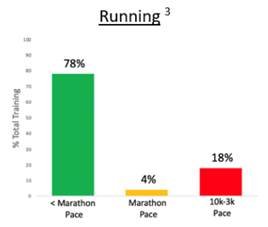However, with the rise of trendy fitness challenges, such as running 5k a day, it is important to consider whether your New Year's resolution will truly make you a better runner. Consider tailoring your training to more specific goals, whether that be running a faster 5k time or building up to a marathon, for example. In this article we explore some of the ways in which you can get the most out of your training in order to reach those goals more effectively.
Managing Your Training Load
When planning your New Year's training, it is important to make sure your training plan is appropriate for you. For instance, if you were to run 5K every day for a month you would expect your fitness to improve and your running pace to get faster. However, is running 5k a day appropriate for your desired outcome?
If your goal is to complete a marathon, running 5k everyday may not adequately prepare you for the demands of a marathon distance. Similarly, if your goal is to run a faster 5k, low intensity endurance runs may not be the most effective training.
Poorly planned training can lead to detrimental effects in your running performance. If you run too frequently, the constant stress applied to your body will prevent muscles from recovering, limiting adaptation to training. Equally, training too much, too quickly, without time for recovery can carry the risk of overtraining and overuse injuries (See figure 1 for common running injuries you may encounter).
These injuries can progress when training load is not well managed, which leads to cumulative strain and stress on your musculo-skeletal structures that then manifests as injury. Initially these injuries may be mild but could ultimately prevent you from running all together.
Away from the physicality of running, without time for rest and recovery or the feeling of progress, you may also risk experiencing burnout and loss of motivation when chasing your fitness goals. Therefore, planning your training to match your desired outcomes is as important as setting your goals in the first place.

So, how do you go about building your training plan to improve your fitness and maintain momentum towards your goals?
The answer is to sensibly build up your training load. In simple terms, your training load is defined by the intensity and duration of your training. This can be split into two categories: acute training load and chronic training load.
Your acute training load is the shorter-term training you just completed, for example the total time you spent running in the last week.
Chronic training load is the training you’ve built up over a longer period, for example 3-6 weeks’ worth of running.
The goal in improving your training load is to improve your chronic training load rather than rapidly increasing your acute training load, which is likely to result in injury. The way to do this is to increase your acute training load by no more than 10% each week.
Research has demonstrated that increasing your load by any more than this puts you in the ‘danger zone’ and at risk of injury. Allow your body to gradually adapt to a higher load before increasing your training intensity further and remember to take breaks when you need them.
You can read more about training load management in our article Run More, Get Injured Less.
The Polarised Training Model
The intensity of your running will also have a key impact on how successful your training is for your running goals. To improve your chances of reaching your goals in 2022, using a polarised training model may provide you with a balanced approach, leading to improvements in your fitness.
Simply put, polarized training means distributing training intensity across three training zones, with the majority of time spent at a lower intensity, around zone 1, with some performed in the highest intensity of zone 3, but relatively little time is spent in zone 2 (See figure 2).
The polarised training approach has been developed via observing the training that top endurance athletes perform which showed ~80% of their training sessions were described as Zone 1 with the remaining ~20% being Zone 3.
You can read more on training intensity distribution in endurance sports here.
Adopting this training model will minimise training at a 'medium intensity', allowing you to prioritise adaptations to the aerobic energy system as well as complete high-intensity training to a much higher quality. A polarised training approach will help avoid overtraining by moderating training intensity and ensure your body has sufficient time to recover and adapt between high intensity sessions. To optimise this structure, it is important to set your training zones at the right intensities.

Understanding Your Physiology
A great place to start is to complete a VO2max and submax test. These are incremental exercise tests, which we provide here at Loughborough Sport. The tests will help identify the strengths and weaknesses in your running physiology and allow you to learn about your physiological profile. A run test at the Loughborough Sports Science Services measures your running economy, lactate thresholds and maximal oxygen uptake.
From this we can determine which physiological aspects are limiting your performance and where improvements can be made, for your specific training requirements. In particular, these tests will accurately identify your training zones and enable you to fine-tune your running.
You can learn more about run tests and how to book them here.
Whatever your running goals for 2022, we hope that these training considerations can help you achieve them. Stay in touch and update us of your progress by following us on social media, @lborosportservices on Instagram.
Good luck and happy running!
Written by Karolina Garbowska and Lois Fileman
Sources
Brenner, J. (2007). Overuse Injuries, Overtraining, and Burnout in Child and Adolescent Athletes. Pediatrics, 119(6), 1242-1245. doi: 10.1542/peds.2007-0887
Muñoz, I., Seiler, S., Bautista, J., España, J., Larumbe, E., & Esteve-Lanao, J. (2014). Does Polarized Training Improve Performance in Recreational Runners?. International Journal Of Sports Physiology And Performance, 9(2), 265-272. doi: 10.1123/ijspp.2012-0350
Myrick, K. (2015). Overtraining and Overreaching Syndrome in Athletes. The Journal For Nurse Practitioners, 11(10), 1018-1022. doi: 10.1016/j.nurpra.2015.08.038
